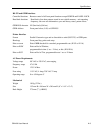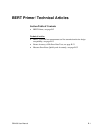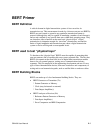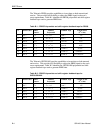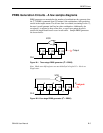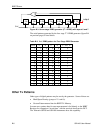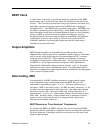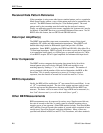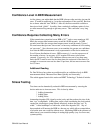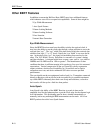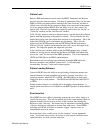
BERT Primer
GB1400 User Manual B-7
BERT Clock
A clock source is necessary to provide the timing for generation of the BERT
digital output, and to provide the logic strobe for acquisition of the data by the
receiver. The Clock must provide clean, sharp logic transitions and needs to be
delayable to account for time the signals from the BERT take to propagate
through the DUT. Most BERTs have an internal clock source. All BERTs have
the ability to operate using an External Clock. Some BERTs have the ability to
derive the internal clock using an External Reference signal at a fixed frequency,
usually 10 MHz, as a basis for increased stability and frequency accuracy.
Providing External Clock allows the possibility of modulating clock frequency
(adding jitter) in order to stress ability of clock recovery circuit in DUT to
withstand conditions of noise and pulse dispersion typically found in data
transmission systems and circuits.
Output Amplifiers
BERT Output Amplifiers are responsible for providing features such as
amplitude offset, peak-to-peak levels, impedances and the degree to which these
may be set and varied for the purpose of accommodating the DUT, or testing
sensitivity levels of the DUT. These amplifiers also determine or limit the
availability of single-ended or differential output. The typical electrical I/O on
our BERTs is a 1-volt signal centered around ground, either Differential or
Single-Ended. Differential outputs provide an inverted “copy” of the output
signal and are used to drive complimentary inputs. If a single-ended signal is
needed, the complimentary output should always be terminated to the appropriate
load to insure best signal quality.
Data Coding, NRZ
Data generated by a BERT is defined according to certain standard voltage
levels, amplitude swings and transitions which the BERT Receiver will
understand as representing a logical “1” or “0”. The most common type of
encoding is “NRZ” (non-return to zero). For NRZ encoding, consecutive 1’s, for
example, cause the output level to hold at the “true” state, rather than changing
between consecutive bits. The level for NRZ only changes when there is a
transition from 1 to 0, or 0 to 1. Other coding schemes are: RZ (return to zero),
CMI, AMI... and many others. Coding schemes may be optimized to make it
easier to recover clock at the far end, or to attempt to keep voltage levels
balanced on twisted pair conductors.
BERT Receiver or "Error Analyzer" Components
For testing using PRBS, the BERT Analyzer relies on its own internal PRBS
generator to provide a standard for comparison with the incoming bit stream from
the device under test. Transmitters and receivers must be set to the same clock
speed and pattern length.



